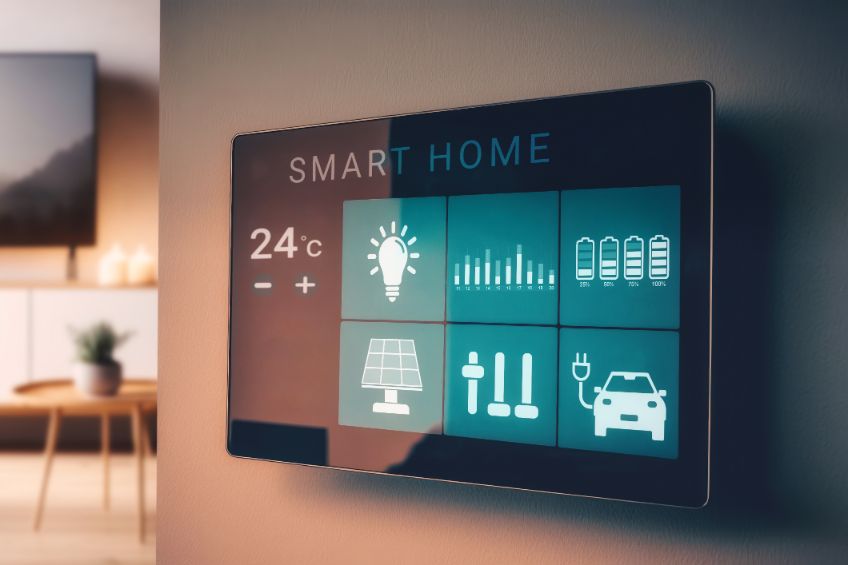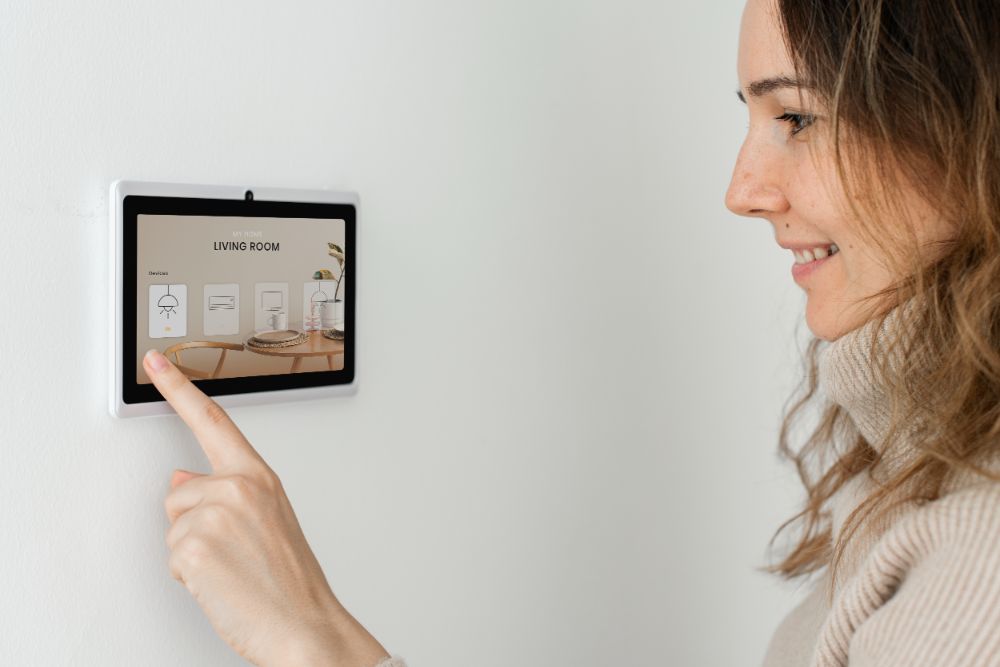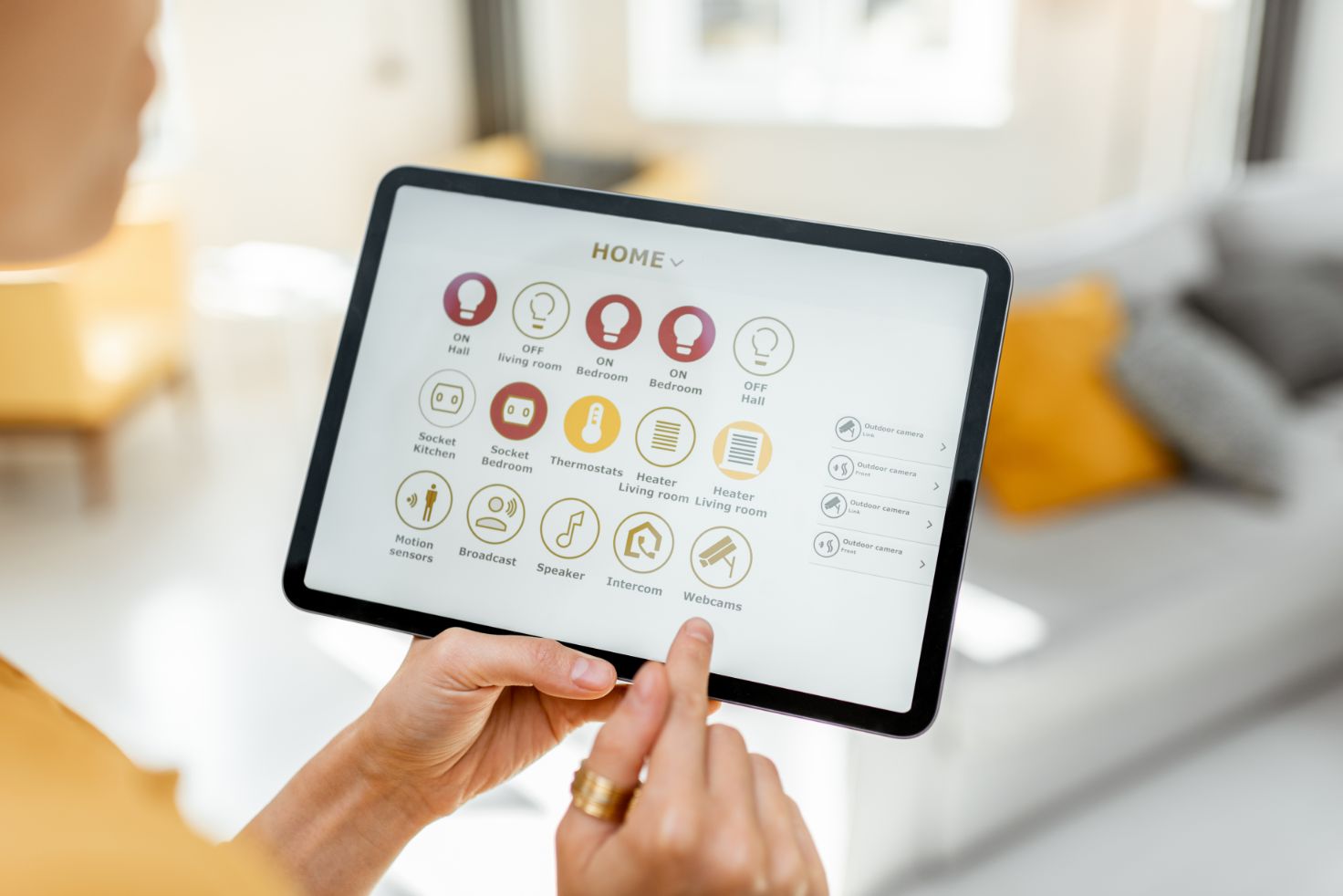The most important factors to consider when choosing a home automation are compatibility with existing systems and devices, and ensuring strong security and privacy measures. For a deeper understanding of these crucial factors, read more explanation below.
Understanding Home Automation
Picture this: you walk into your house, and the lights automatically turn on, the thermostat adjusts to your preferred temperature, and your favorite music starts playing softly in the background. All this magic is made possible through the marvels of home automation. In this section, we’ll delve into the essential basics of home automation, giving you a solid foundation to explore the exciting possibilities it offers.
At its core, home automation is the integration of various electronic devices and systems within your home, enabling them to communicate and operate intelligently. These smart-systems work together to streamline your daily routines, enhance security, and create a personalized living space that adapts to your needs. But how does it all work? Well, the magic begins with a central hub or controller, which serves as the brain of your smart home. From here, you can connect and control a wide range of devices, such as smart lights, thermostats, door locks, cameras, and even kitchen appliances, all from the convenience of your smartphone or voice-activated virtual assistant.
The heart and soul of home automation lie in the ability of these devices to communicate with each other through a network. Each device has its unique set of capabilities and functions, allowing them to exchange information and work in harmony. But the real magic is in the automation part – the ability to set up routines and scenarios that trigger specific actions based on predefined conditions. For example, you can program your smart thermostat to lower the temperature when you leave the house or set your smart blinds to open automatically at sunrise. The possibilities are virtually endless, and it all starts with understanding the fundamental concepts of home automation.
Evaluating Your Home’s Automation Readiness

Before you dive headfirst into the realm of smart homes, it’s essential to assess your home’s readiness for this technological revolution. Just like preparing for a thrilling adventure, you need to ensure your home is equipped to handle the wonders of automation. In this section, we’ll guide you through the process of evaluating your home’s automation readiness, helping you make informed decisions on your exciting journey ahead.
The first aspect to consider is your home’s network infrastructure. A reliable and robust network is the backbone of any successful home automation system. With an increasing number of smart devices relying on Wi-Fi connectivity, it’s crucial to have a stable and high-speed internet connection. Dead zones and weak signals could hinder your smart devices from communicating effectively, leading to frustration instead of convenience. Consider upgrading your router and possibly adding range extenders to ensure seamless coverage throughout your home. Additionally, you may want to explore options like Ethernet connections or mesh Wi-Fi systems for even better performance.
Next, take a tour of your home to identify potential automation opportunities. List the tasks or actions you’d like to automate, such as controlling lights, adjusting thermostats, or monitoring security cameras. Consider the types of devices you’ll need and their ideal locations. Moreover, think about your daily routines and how automation can complement them. For example, if you’re a morning person, setting up automated wake-up routines that gradually raise the blinds and play your favorite upbeat music can start your day on a cheerful note. Understanding your needs and preferences will help you narrow down the choices and find the perfect home automation setup that fits seamlessly into your lifestyle.
Lastly, don’t forget to consider your budget. Home automation offers a wide range of possibilities, but costs can vary significantly depending on the complexity and scope of your setup. Set a realistic budget and prioritize the areas you’d like to automate first. Keep in mind that home automation is an investment that can enhance your living experience and even increase the value of your property. So, evaluate the long-term benefits as you weigh your options.
Now that you’ve evaluated your home’s readiness, you’re one step closer to transforming your living space into a smart haven. In the upcoming sections, we’ll delve deeper into crucial factors to consider when choosing specific automation devices and systems. From compatibility and security to energy efficiency and user-friendly interfaces, each factor plays a vital role in creating a smart home that delights and simplifies your life.
Integration with Existing Systems

One crucial aspect that can make or break your smart home experience is how well these new-fangled technologies integrate with your existing systems. In this section, we’ll unravel the mysteries of seamless integration, ensuring that your current setup harmoniously dances with the new stars of home automation.
Before you start shopping for smart devices, take stock of the systems you already have in place. Whether it’s your home security, lighting, heating, or entertainment systems, understanding their compatibility with potential automation devices is paramount. Many modern smart home products are designed to be compatible with widely-used protocols like Wi-Fi, Zigbee, and Z-Wave, making integration more straightforward. However, it’s essential to check for any limitations or specific requirements, especially if you have older systems or devices that use proprietary protocols.
Now, you may be wondering, “Why is integration so vital?” Well, the secret lies in the symphony of automation. Imagine being able to control all your smart devices from a single app or hub, orchestrating a harmonious routine that suits your needs perfectly. This is where compatibility and integration shine, transforming your smart home from a collection of gadgets to a cohesive ecosystem that works effortlessly together. No more juggling between multiple apps or struggling with incompatible systems – a seamless integration ensures a smoother and more enjoyable experience.
Moreover, integration expands the realm of possibilities for your home automation. When systems communicate and share data, you can create more intricate and intelligent automation routines. For example, your smart security cameras can trigger the lights to turn on if any motion is detected, or your smart thermostat can adjust the temperature based on occupancy data from motion sensors. The result is not just convenience, but true synergy among your devices, maximizing their potential and making your smart home truly smart.
As you navigate the world of home automation, keep your eyes peeled for products and brands that boast strong integration capabilities. Research customer reviews and expert opinions to get an idea of how well these devices play with others. Additionally, don’t forget to check for compatibility with your preferred voice assistants, as voice control can be a significant convenience factor. With seamless integration, you’ll be well on your way to transforming your home into a symphony of smart technology, where each device plays its part harmoniously to create an experience like no other.
Security and Privacy Concerns in Home Automation

As you embark on your quest to create a smart home, one of the most critical factors to wield in your arsenal is the shield of security and privacy. In this section, we’ll delve into the realm of digital defenses and unveil the essential considerations to safeguard your home automation kingdom from potential threats.
As you embrace the wonders of home automation, it’s essential to be aware of the vulnerabilities that come hand-in-hand with interconnected devices. Each smart gadget you introduce into your home becomes a potential entry point for cyberattacks. To bolster your defenses, always opt for reputable brands that prioritize security. Check for devices that receive regular firmware updates and have built-in security features like encryption and two-factor authentication. Additionally, choose products that have been certified by reputable security organizations, as this provides an extra layer of reassurance.
Now, let’s talk passwords – the gatekeepers of your digital domain. The path to secure home automation begins with strong, unique passwords for each device and app. Avoid default passwords, which are often easily guessable and a favorite target for hackers. Get creative, mix in a blend of letters, numbers, and special characters, and make your passwords as resilient as a medieval fortress. And while we’re on the topic of access control, consider setting up user accounts with different levels of privileges. Not everyone in your household may need access to all features, so tailor permissions accordingly.
As you venture deeper into the smart home realm, you’ll encounter a plethora of devices that collect and process data to enhance their functionality. This brings us to the delicate matter of privacy. Take the time to understand the data collection practices of the devices you bring into your home. Ensure that manufacturers have clear and transparent privacy policies, outlining what data is collected, how it’s used, and who it’s shared with. Look for devices that offer features like local storage and on-device processing, reducing the need to send sensitive data to the cloud.
By fortifying your smart home with robust security measures and mindful privacy practices, you can revel in the delights of home automation without compromising your peace of mind. In the upcoming sections, we’ll uncover more critical factors to consider when selecting your home automation devices. From seamless integration and energy efficiency to user-friendly interfaces, we’ll equip you with the knowledge and prowess to build a smart home that truly empowers and protects.
Scalability and Future-Proofing Your Home Automation Setup

It’s essential to plan for the ever-changing landscape of technology. The world of home automation is a dynamic realm, and to thrive in it, you must wield the power of scalability and future-proofing. In this section, we’ll unravel the mysteries of building a flexible and enduring smart home setup that can adapt and grow with the tides of innovation.
When choosing home automation devices, think beyond the present and envision the future. Your needs and preferences may evolve, and technology will undoubtedly advance. Embrace the principle of scalability – the ability to expand and enhance your smart home ecosystem seamlessly. Start with the basics, but keep an eye on devices and systems that can be easily integrated into your existing setup later on. This not only saves you from costly replacements but also ensures a smoother transition as you add new layers of automation.
A key aspect of scalability lies in the hub or controller you choose. This versatility empowers you to connect and control a wide range of devices, even those that use different standards. Additionally, explore hubs that have strong compatibility with third-party products and can work with popular voice assistants like Alexa, Google Assistant, or Siri. This way, you’ll have the flexibility to incorporate new devices and features without hitting a dead end.
Future-proofing your smart home also involves keeping an eye on emerging technologies and standards. For instance, consider devices that support the latest advancements like 5G connectivity or have the potential to integrate with upcoming smart home ecosystems. Stay informed about industry trends and attend technology events or read expert reviews to stay ahead of the game. By planning for the future, you’ll ensure that your smart home remains at the cutting edge of innovation, ready to embrace new possibilities as they arise.
With the power of scalability and future-proofing at your side, you’ll build a smart home that stands the test of time. As we continue our exploration of essential factors to consider in home automation, we’ll uncover more gems of wisdom. From user-friendly interfaces and energy efficiency to understanding compatibility and the importance of security, each factor will pave the way for a smart home that adapts, delights, and empowers you every day.
User-Friendly Control Options

You’ll soon find yourself surrounded by an array of gadgets, each vying for your attention. But fear not, for the key to unlocking the true magic of your smart home lies in the realm of user-friendly control options. In this section, we’ll delve into the world of seamless control, helping you discover the most intuitive and delightful ways to interact with your ever-growing collection of smart devices.
The heart of user-friendly control lies in finding an interface that feels like second nature to you. While smartphone apps are the go-to control option for many, consider exploring other options that align better with your lifestyle. Voice control, for instance, can be an enchanting way to interact with your smart home. Just speak a simple command, and watch the magic unfold as your lights dim, the temperature adjusts, and your favorite playlist starts playing. With popular voice assistants like Alexa, Google Assistant, and Siri, the possibilities are as limitless as your imagination.
But wait, there’s more! For those who prefer a tactile experience, smart home hubs equipped with touch screens offer an elegant and interactive control solution. Imagine having a dedicated control center where you can adjust settings, view camera feeds, and manage all your devices with just a few taps. The hub becomes the captain’s wheel, steering your smart home with ease.
Of course, we can’t forget the classic remote control, reinvented for the digital age. Smart remotes allow you to command your devices from the comfort of your couch, acting as the conductor for your home automation symphony. From controlling your entertainment systems to managing lighting and blinds, these remotes simplify your smart home experience without compromising on convenience.
As you select your user-friendly control options, consider the level of integration they offer. Ideally, you want a control solution that can seamlessly interact with all your smart devices, regardless of the brand or protocol they use. Compatibility is the key to ensuring a cohesive and delightful smart home experience.
Energy Efficiency Considerations

It’s essential to chart a course that leads to a greener and more energy-efficient future. In this section, we’ll navigate through the seas of sustainability, uncovering the crucial considerations to ensure your smart home not only brings convenience but also helps you save the planet – one smart choice at a time.
When selecting home automation devices, look for the Energy Star label – a beacon that signifies products meet strict energy efficiency standards set by the U.S. Environmental Protection Agency. These energy-efficient devices can significantly reduce power consumption, leading to lower electricity bills and a smaller carbon footprint. From smart thermostats that optimize heating and cooling to energy-efficient smart bulbs that use less electricity, these green companions are worthy allies in your quest for sustainability.
Next, embark on a quest for knowledge and understanding of each device’s power consumption. Research and compare the energy usage of different models to make informed choices. Keep an eye on devices that have power-saving features, such as automatic shut-off or sleep modes. Devices that can detect occupancy or activity and adjust their energy usage accordingly can also contribute to a more efficient smart home. Additionally, explore smart plugs and power strips that allow you to control the power supply to connected devices, preventing unnecessary energy drain when not in use.
There’s more treasure to be found in the vast seas of renewable energy! Consider incorporating solar power into your smart home. Solar panels can provide a clean and sustainable source of electricity, powering your devices and even sending excess energy back to the grid. Pair your solar setup with smart energy monitoring devices to track your usage and optimize your consumption for maximum efficiency.
With your sails set for energy efficiency, you’ll not only reduce your environmental impact but also enjoy the benefits of a greener and more budget-friendly smart home. As we continue our voyage through the factors to consider in home automation, we’ll explore more exciting aspects. From user-friendly interfaces and security measures to scalability and future-proofing, each element plays a vital role in shaping your smart home into a sanctuary of sustainability and innovation. So, onward we sail, valiant stewards of technology, as we embrace the wonders of a smarter, greener tomorrow!
Budgeting Costs and ROI

It’s really needed to weigh the coins in your chest and chart a course that leads to the best return on your investment. In this section, we’ll set sail on a financial adventure, uncovering the hidden costs and rewards that come with building a smart home worthy of a captain’s admiration.
It’s easy to get lost amidst the allure of cutting-edge technology. But fear not, for a wise captain always keeps a keen eye on the treasure map of budgeting. Set a clear budget before embarking on your smart home journey, and stick to it as closely as a ship navigating through treacherous waters. Research the costs of various devices and systems, and don’t forget to account for additional expenses such as installation fees, subscriptions, and maintenance. Staying within your budget ensures a smooth voyage, free from financial storms that might otherwise capsize your smart home dreams.
Now, let’s talk about the bounty that awaits you – the return on your investment (ROI). While building a smart home requires an initial investment, the potential rewards can be bountiful. Look for devices and systems that offer tangible benefits, such as energy savings, reduced utility bills, and increased home security. A smart thermostat, for example, can help you optimize your heating and cooling, potentially saving you a tidy sum on energy costs over time. Similarly, smart lighting that automatically adjusts based on occupancy can lead to significant savings in electricity bills. Consider the long-term financial gains and weigh them against the upfront costs to make informed decisions that offer a prosperous ROI.
There’s more to uncover in the vast seas of smart home economics. As you plan your budget and assess the potential returns, also consider the life cycle of your devices. Technology evolves rapidly, and some devices might become outdated sooner than others. Opt for products that have a longer life span and can be easily upgraded through firmware updates. This way, you’ll extend the usefulness of your investments and sail smoothly into the future without the need for frequent replacements.
Researching and Comparing Home Automation Products and Brands

The time has come for your detective hats and embark on the exhilarating quest of researching and comparing the finest treasures in the realm of smart devices and brands. In this section, we’ll set sail on a thrilling adventure of discovery, guiding you through the process of unearthing the gems that will adorn your smart home empire.
First and foremost, let us hoist the flag of research! Dive deep into the ocean of information available at your fingertips. From expert reviews and customer feedback to in-depth articles and comparison charts, cast your net wide to gather valuable insights on different home automation products and brands. Pay special attention to features, functionalities, and user experiences, as they will shape the heart of your smart home. Keep notes of the devices that catch your eye, and create a list of potential contenders to consider.
As you navigate the vast seas of options, comparing each product’s performance and compatibility is crucial. Consider the protocols they use, whether they support popular voice assistants, and how well they integrate with your existing systems. Compatibility is the compass that guides you in building a seamless smart home ecosystem where all devices work together harmoniously. Don’t forget to examine the quality of customer support and warranties, as they can be lifesavers when you encounter stormy weather on your smart home voyage.
But wait, there’s more treasure to be discovered! Set your sights on reputable brands known for their commitment to quality and innovation. Look for manufacturers with a proven track record, as they are more likely to stand the test of time and offer reliable products and services. A brand’s reputation is like a lighthouse, guiding you towards trusted and dependable devices that will shine in your smart home kingdom.
We have one last valuable gem to share with you. For our top recommendation on a standout home automation product that excels in both performance and user satisfaction, we invite you to check out this link. It’s our trusted compass to guide you in choosing a device that will elevate your smart home experience to new heights. Bon voyage and happy home automating!

